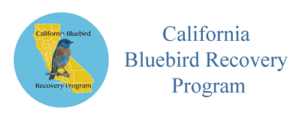Nest Box Monitoring
Left Top: Oak Titmouse at box on tree. Left Bottom: Violet-green Swallow on Noel Guard. Photos: Maren S. Smith. Center: Monitor, Sue Cossins, uses a retriever to place a box high in a tree. Photo: Bob Cossins. Right: Western Bluebird feeding at box on a pole. Photo: Sylvia Wright
Monitoring your nest boxes will increase the chances of the nesting bird’s success. Learn how to monitor your nest boxes, what to bring with you, how to clean and repair your boxes, and how to resolve many challenges.
Why and How to Monitor Nest Boxes
Nesting birds face many challenges. One big tool you have to assist them is regular monitoring. We ask that you monitor your nest boxes weekly. Here is why.
Monitoring your nest boxes will increase the chances of the nesting bird’s success. Wasps can build their nests inside the box, preventing the birds from using it. Cracks in the roof or the seams of the box can cause rain to leak inside. Squirrels and woodpeckers can make the entry hole bigger and allow predators to access the box. The nestlings might be abandoned because their parents were killed. Grass allowed to grow tall around the pole or tree can be cover for snakes. Blow flies or fire ants can invade a nest and kill the nestlings.
Unmonitored boxes can also become House Sparrow houses and once the population takes hold can drive native birds out-of-the-area. These are but a few examples of why monitoring is important. We will discuss how to handle each of these and other problems in the section called “Challenges”. The nest box monitor observes the nest box for problems, resolves them, gathers data, thus, increasing the chances for a successful nest.
There are different styles of nest boxes but the techniques here can be used on all songbird nest boxes. Our main concerns are safety for the birds (and for you), identifying problems and resolving them, identifying species, counting eggs, hatchlings, and fledglings and keeping data to turn in at the end-of-the-season.Generally, the nesting season starts as early as January and is done about the end of July or August. A minimum once-a-week box check is industry standard for trail monitors. If you wait to check every two weeks, an entire part of the nesting cycle may have been completed. You might miss critical problems if you don’t check them weekly.
How you access your boxes will vary depending upon how they are mounted. Nest boxes are installed any number of ways. Some monitors use step ladders or the Dick Purvis Box Lifter to reach their boxes. However, the boxes are installed, the basics are the same. Safety for you AND the birds is critical.
- When approaching the nest box, look and listen for activity around the box. Bluebirds and Tree Swallows might swoop down close to your head when you approach. Parent birds will often perch in a nearby tree and watch nervously, then fly in to check their nests as soon as you leave. They are trying to protect their nests, and it is important the monitor gets in and out quickly. We do this out of respect for the birds, but the fact is birds don’t abandon their nests due to nest box monitoring if done correctly.
- Make your presence known. Tap on the nest box gently with your walking stick or knuckles to give an adult the chance to fly out.
- In the last few days of being in the nest box, hatchlings get close to fledging. This can be a problem when the birds fledge early, before they’re ready. To avoid this, you can stuff a scarf into the entrance hole before opening the nest box. Additionally, don’t monitor the box after chicks are 14 days old. Older chicks must be fed more often, and you can watch for parent birds going back and forth to the nest box and you will hear the young chirping.
- Open the box. This may require a screwdriver. Or if you have a hanging nest box, you will use your Dick Purvis Box Lifter to take it down.
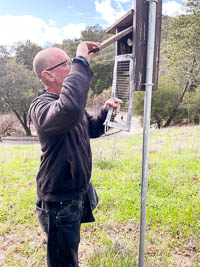
- Open the door slowly. You can use a screen made of hardware cloth to slide up over the open space to assure that nothing falls out. The screens are easy to make.
- Making a Protective screen: You’ll need hardware cloth, Duct tape and a clip.
- Cut a piece of hardware cloth about 7 ½” wide and 14” long big enough to cover the door when you open it.
- Cover edges of hardware cloth with duct tape.
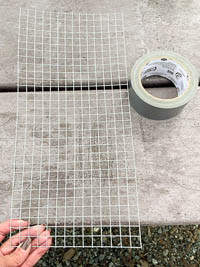
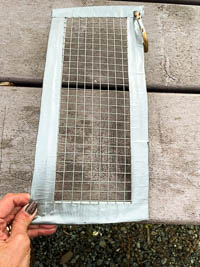

- Clip to your bag to keep it handy.
Lee Pauser, a nest box monitor who’s fledged thousands of birds, altered the side door to open from the bottom. In this way, the nest and chicks won’t fall out. You wouldn’t need to use a screen for this style box. Top opening boxes are opened and checked from the top; some monitors prefer this style.
- If you see an incubating parent, close the door, and leave. Nesting birds are very protective of their eggs and young. It is not unusual to open a box and find a parent who has refused to leave and is defiantly sitting on her nest. We advocate not touching the birds if possible.
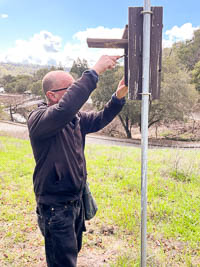
- If you see it is safe to keep the door open for a minute, you can remove the screen. A dental or mechanics mirror is helpful to look inside the nest without disturbing it. You can identify the species, count the eggs or nestlings, and look for problems. Don’t feel around in the nest because you might find a surprise like mice, spiders, wasp… and or you might injure a baby bird.
Keep in mind this is a very stressful experience for nesting birds. Please, go in and out as quickly as you can do so safely. Address any problems you see.
- Close the door slowly and secure the box. Remove the scarf from the entry hole if you used one.
- Record your data. Make a note on your log of what you see, what kind of nest, how many eggs, how many nestlings, any evidence of problems, how you dealt with them and what needs to be repaired later.
- Limit photographs that might distress occupants. Keeping the door open can chill the nestlings, interfere with their feeding schedule plus frighten the parents.
- Do not open the nest box if it’s raining or cold (less than 50 degrees) even if it’s the seventh day UNLESS you suspect there is a problem. Reschedule. Try to monitor during dry, calm weather conditions.
- If you cannot monitor your trail another season, please, contact your County Coordinator to help you find another monitor to adopt it. Even after a season or two the birds may become accustomed to the locations of the boxes and may well depend on them for nesting. If you don’t have a County Coordinator, you can contact your local Audubon Society to help you find someone and if those two options don’t work, please, contact us.
It is a privilege to observe the nesting birds because we witness intimate stages of life. The birds do tolerate us, but it is important to keep in mind they are wild. We do not want to tame them. We can appear to be giant, scary predators. We encourage monitors to be respectful of the nesting birds, and to learn more about their species and habitats to understand their behaviors and needs better. Monitoring nest boxes increases successful fledging, and we will give you the knowledge you need to be a confident and effective nest box monitor.
What to Bring with You
Here is a list of tools we recommend you take with you as you head out onto the bluebird trail. Monitors have different ways of organizing their tools and have their own ideas about which tools they should bring along. This is a list of items that our long-time monitors find useful. You will figure out what works for you.
First, here are personal items to consider:

- A roomy side-bag, a daypack, tool belt or fishing vest.
- A comfortable hat for sun protection
- Cell phone with GPS app
- Walking stick
- Water
- First-aid kit
- Insect repellent
- Snack
Secondly, these are the tools you may want while you monitor your boxes:
- Cell phone to record data, Data Forms or notebook with pen.
- Box lifter if you have hanging boxes in trees.
- Screwdriver, either manual or battery operated. A manual screwdriver is always wise in case the battery fails on the power version.
- Needle nose and standard pliers.
- Putty knife or paint scraper for lifting the nest out and for scraping out debris.
- Stiff brush for cleaning.
- Dental or mechanics mirror to look at the eggs and nestlings.
- Scissors
- Door Screen for a side-opening box (note: easy to make out of hardware cloth and duct tape plus get a clip to attach to your bag. Instructions and photos in the How-to Monitor section.)
- Scarf or cloth to use to plug up the entry hole
- Gloves (leather and/or rubber)
- Dust Mask. (wear when cleaning to avoid dust particles)
- A few small towels and paper towels
Also, some items that can come in handy:
- Diatomaceous Earth
- Extra screws and small nails
- Zip Lock bags
- Small plastic container for dried grass
- Small Garbage bag, paper sack
Cleaning and Repairing Nest Boxes
Cleaning your nest boxes is part of being a responsible monitor! There are different times and reasons to clean them out:
During the nesting season, once the nestlings have fledged, it is best to remove the nest. There are a number of reasons. Parasites and bacteria can build up and removing the old nest can reduce such problems. Now that the cavity is ready for a second brood or a new pair, a new nest will have to be constructed over the old one. If you are checking weekly, you will usually have a chance to remove the old nest. If you don’t, the new nest will be taller (built upon the old nest) and the nest cup with hatchlings will be closer to the entry hole. This will put the nestlings in peril.
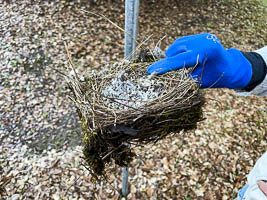
Remove old nests at the end of the season and assess what repairs need to be made or if the box needs to be replaced.
How to Clean out the Nest Box
We recommend:
- Disposable gloves
- Dust Mask (to avoid ingesting harmful fecal dust)
- Plastic bag
- Putty knife or paint scraper
- Wire brush
- Spray bottle with 10% bleach/water or vinegar water for disinfecting
- Wearing your mask and gloves, use the putty knife or paint scraper to lift the old nest out of the box.
- Place the old nest in a plastic bag for disposal. If you didn’t bring a bag, leave it at least 20 feet from the nest box to avoid attracting predators.
- Scrub bottom and sides of the box with the wire brush.
- Spray with disinfectant, let the box dry and close.
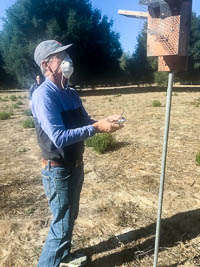
It is not necessary to disinfect the box after each nest is completed but we do suggest doing this at the end of the season.
Repairs:
After the nesting season is complete, check those boxes for a final fall inspection.
If the roof is cracked, seams are separated, etc., you may need to remove the box, repair at home and then reinstall. Make sure your predator guards are attached properly and in working order.
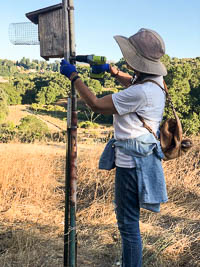
If the roof is cracked, seams are separated, etc., you may need to remove the box, repair at home and then reinstall. Make sure your predator guards are attached properly and in working order.
By cleaning and repairing your nest box you will not only prepare it for the next nesting pair, you’ll also be making it available for roosting in the fall and winter. Where do birds huddle together during the frigid winter mornings? Your box. And when it is freezing outside, it is often easier just to relieve themselves inside. You understand. Just scrape out the winter debris and get the box ready for spring.
And once again, as spring approaches, it is time for one more inspection. Winters can be hard on nest boxes. You will want to check all the boxes again and clean out any feces if the birds did use it for roosting! Then it’s time to start a whole new season of nesting.
How to Resolve Challenges
There are a number of challenges birds face in raising their young. These challenges may require attention from a nest box monitor. Keep in mind that while we do what we can to provide a safe place for the birds to nest, there are situations we cannot control. Even tragedy in the bluebird world means another day of making a living for a predator or their own babies. Nature reminds us of this on the trail. Then again, there are times when our intervention saves lives!
All the native life forms in the habitat have their natural place. Learn as much as you can about their life cycles to understand behaviors. Bees, snakes, bats, etc., are all important inhabitants of their ecosystems.
Let’s talk about the kinds of predators looking for something to eat.
Snakes and Lizards
Here in California, the prevalent snake predating the bluebird nest box is the nonvenomous, endemic, Pacific Gopher Snake (Pituophis catenifer catenifer). It’s not a small snake and can be intimidating. Their pattern is similar to a rattlesnake and can even imitate one when threatened. Rattlesnakes don’t like climbing but, of course, keep your wits about you when you are walking around in rattlesnake country in case they are near your box!
Just because a Gopher Snake is not venomous does not mean you should reach in with a hand to pull it out. Use a big stick, being careful not to injure it and gently lift to the ground. The Gopher snake will be happy to crawl away.
There are different clues a snake will leave if it “struck” your nest box. The calling card of a snake is everything appears undisturbed, but the eggs or babies are gone. If this was a pole mounted box, consider installing two predator guards. The Noel Guard for the entry hole and a stove pipe baffle under the box. Keep the Noel Guard spikey at the ends because a snake will not want to crawl over the exposed wire. This does not harm the birds nor discourage them from going in and out of the box.
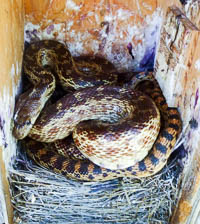
Here in California, the prevalent snake predating the bluebird nest box is the nonvenomous, endemic, Pacific Gopher Snake (Pituophis catenifer catenifer). It’s not a small snake and can be intimidating. Their pattern is similar to a rattlesnake and can even imitate one when threatened. Rattlesnakes don’t like climbing but, of course, keep your wits about you when you are walking around in rattlesnake country in case they are near your box!
If you have both guards and you suspect a snake managed to predate your nest box anyway, more than likely it was a BIG Gopher Snake. In this case you might want to move the location of the box so the “educated” snake does not return in a few weeks.
If you have tree mounted boxes, you can wrap the trunk of the tree with an acetate sheet (transparent sheet of flexible plastic, 32 in tall and about 0.04 in thick) and secure with duct tape around the top.
Jumping off points could be other trees or branches. Add another acetate predator guard on those trees also. Be mindful of how branches are in relation to the nest box as well.
Alligator lizards and the Western Fence lizards have been known to show up in nest boxes every now and then. It isn’t always easy for them to get there so they don’t necessarily make repeat visits. Once they see you, they will quickly escape.
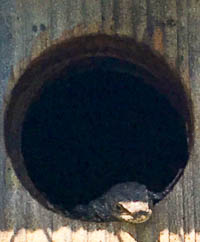
Raccoons
Raccoons can be a real headache. They’re widespread and always a threat but they aren’t a problem most of the time. But when they strike … oh boy! Raccoons are strong and can rip the roof right off what was a sturdy house. They are smart, have agile hands and if they find an active nest, they will look around for other nest boxes to raid next. They’ve been known to hit several boxes on a nest box trail! Once they do this, they must be considered a threat in the future.
Hanging boxes are not immune to raccoons. One CBRP County Coordinator watched a raccoon lift a hanging nest box off the branch, drop it to the ground and eat the nestlings inside. If a raccoon marauds your hanging nest box, move the box to another tree and perhaps, use another style of box so the raccoon doesn’t recognize it. By far, pole mounted nest boxes with Noel Guard and baffles are the best to keep raccoons out. But you may not have this option. Contact us for ideas if raccoon predations occur on your trail and you run out of solutions.
Feral and Outdoor Cats
According to the American Bird Conservancy, “outdoor domestic cats are a recognized threat to global biodiversity. Cats have contributed to the extinction of 63 species of birds, mammals and, reptiles in the wild and continue to impact a wide variety of other species, including those at risk of extinction such as Piping Plover. The ecological dangers are so critical that the International Conservation of Nature (IUCN) lists domestic cats as one of the world’s worst non-native species.
In the United States alone, feral and outdoor cats kill approximately 2.4 billion birds a year.”
The implications here speak for themselves. Prevention is the best policy by not installing nest boxes where you know cats are prowling.
Mice, Rats, and Squirrels
Nest boxes may be attractive homes for California Deer mice, Roof rats and Woodrats. To be sure, this isn’t a great situation for our native songbirds, but these rodents are part of the food chain and natives themselves. If your nest box trail is in a public park, you may not be legally allowed to evict them.
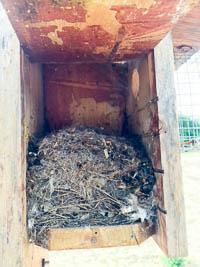
We don’t recommend cleaning the nest out if you see there is a live nursery or if it is in winter. To see if there is a live nursery you can (wearing mask and gloves) gently poke into the nest to uncover baby mice. If so, cover them back up and leave.

One solution is to install another nest box nearby or clean out the nest when the nursery is gone and in early spring.
Always wear a mask and gloves when cleaning out nest boxes, especially if they are inhabited by mice. You don’t want to breathe in fecal dust.
Prevention, if possible, is the best solution. Install the box far enough away from tree branches and shrubs to prevent rodents from jumping onto the box. Wooden posts can be protected with baffles under the box, as can pole mounted nest boxes.
Squirrels can stand on top of a box and chew at the entry hole to make it bigger. If this happens, they get inside and start a family please, leave the nest alone until the babies are grown and have left. They might have two litters.
The Noel Guard prevents this and if you leave the end a bit spikey, all the better. Skinny, long squirrel arms don’t like to get scratched and the spikiness does not deter nor injure the nesting birds. Also, use a metal entry hole guard. Do not attempt to evict them.
Bees, Paper Wasps, Spiders and Ants
It is rare but from time to time, nest boxes are taken over by honeybees. This is usually when they are in swarm mode and only lasts a few days. If they do not move on, contact a member of a local beekeeping society, and have the hive removed. The beekeeper will relocate the Queen and her hive.

A Yellow-faced Bumble Bee (Bombus vosnesenskii) Queen may claim your nest box for her domain in early spring to raise her offspring or use it to overwinter in. They really like old spent Chickadee nests, which are soft and make a good substrate for the start of a bumblebee colony. Her life cycle lasts one season, and the nest box is rarely used again.
At the end of the season, the Queen dies, and future Queens overwinter until spring. If you see these bumblebees in your nest box, please, don’t evict them. You can install another box nearby and clean out the bumblebee nest when it is empty. Native pollinators are in trouble and the reason the bumblebee has chosen your nest box is because she is desperate for housing.
Paper Wasps are a frequent nest box visitor that rarely usurp birds from their boxes. They like boxes in the warm sun, mostly in empty boxes in early spring. Typically, the comb will be small and attached to the ceiling. Some monitors will wait until nightfall when it is cool (the wasps are weather driven) and simply sweep the nest out.
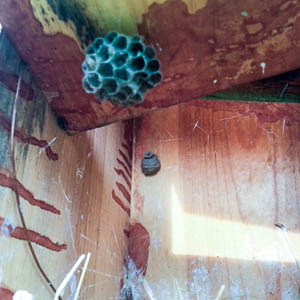
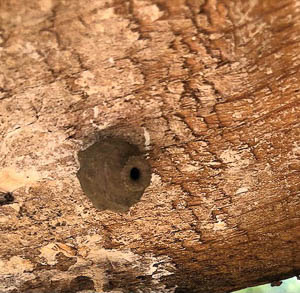
Another common wasp is the Potter’s Wasp. She builds a perfect “pot” made of mud that you can scrape off. In this image she built her nest deep in a hole in a fallen tree trunk.
Remedies include better ventilation, especially around the top, plus you can rub a bar of soap on the ceiling to keep them from attaching their nests. You can plug up the ventilation vents in the winter to prevent them from coming in and remove them when nesting season begins. Do not use pesticides because the residual can harm the birds.
Spiders visit empty nest boxes or boxes with spent nests. They might build a web, set up a home and stay if they can. We advise monitors not to evict them. Eventually a bird will claim the nest box, the activity will scare the spider away or the bird will eat it. In either case, you don’t need to worry about it staying around for very long.
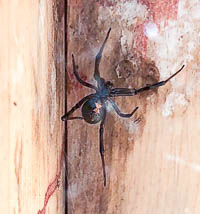
Ants can be a problem. We’ve seen the little argentine ants in large numbers in a nest box but they don’t attack the chicks. We’ve also seen ants that are clearly doing their scavenger thing on dead chicks. Did the ants kill the chicks? It is impossible to know.
Ants are annoying to the birds and even if they are not fire ants should be eliminated out of the box. Fire ants are a serious problem in some areas of California. They kill and eat the nestlings. A nest box that has been attacked consistently by ants must be relocated. Ants are clearly living nearby and consider this location part of their territory
If you see one or two ants, it is because they are scouting. Don’t wait until they infest your nest box. You can do the following to control ants:
- Look at where the ants are entering the box. Once you determine where the entry point is you can decide how to deal with the problem.
- Making sure the nestlings are safe, gently lift the nest up with your putty knife to see if there are ants’ underneath. You may have to remove the nest and the nestlings (similar procedure as to changing a wet nest but you may not have to change the nest), brush ants off the nestlings and brush any ants out of the box. Sprinkle food grade Diatomaceous Earth on the floor of the box before placing the nest back inside.
- Pole mounted nest box: Tape Garden tape tightly around the pole snugly under the box. Better yet, if you have a baffle, do this under the baffle instead. Tree Tanglefoot does not melt in the heat the way Vaseline and some other greasy materials will. Axle grease works also. The tape is important so that the Tanglefoot or grease is confined to that area. Once the Tanglefoot or Axle grease is hardened (you may have to reapply twice during the season) you can cut the tape off, retape and reapply.
- Hanging box: Per Lee Pauser, an expert with hanging nest boxes who uses Tanglefoot with the brush applicator as opposed to the tube that can get messy thus, more difficult to apply: “I use a product called Tanglefoot to stop them from coming down the wire. I prefer the can that includes a brush. Care MUST be taken to avoid applying it where a bird might come in contact with it, so I apply a band of it completely around the wire just below the hanger wire’s hook. The band could be 1/2″ to 1″ wide or so. It becomes less effective as the surface hardens or enough ants get stuck in it to form a bridge. It may need to be refreshed the next week. One also needs to be careful not to contact it when handling the box as it is hard to clean off.”
- Tree mounted box: This method of attachment is the most difficult to protect from ants and predators in general. Sweep all ants out of the box and apply the food grade Diatomaceous Earth to the floor of the box. Find entry points but do not apply Tanglefoot on the top of the box to prevent birds from contacting it. You may have to check the box every day if not several times a day to make sure the ants have not come back. This is especially true of Fire ants. If this is a persistent problem your box is close to an underground ant colony, and you’ll need to relocate the box.
Caution
Using any type of grease or oil is dangerous to use around birds so you want to be sure to wear gloves, have a disposable applicator to apply it with and apply a layer onto the tape. If a bird does get Tanglefoot or another type of grease on it, take it to a rehabber immediately.
Blowflies
If you detect blowflies in your nest box, change the nest completely. Check the nestlings for blowfly larvae and pick them off. Directions below on how to safely change a nest. Dust a layer of food grade Diatomaceous Earth on the floor of the box.
How to Change Wet or Badly Soiled Nest
There are a variety of reasons why you may have to change a nest. Maybe it is wet due to a faulty nest box that leaks during a rainstorm, or you find blow flies, an ant infestation or the nest is gooey because of fruit or other food being fed to the nestlings. In any event, it is not hard to change a nest and the parents won’t abandon their eggs or babies.
If the nestlings are fully feathered, you are going to have a bigger challenge because they might prematurely fledge. Extra care needs to be given in this case.
It is helpful to keep your “tool kit” stocked with essentials. Also, if you find a good nest at the end of the season, save it. You might need it for such an occasion like this.
Here is a list of tools and items to keep on hand. Some monitors keep extra items in the trunk of their cars or pull a cart when they monitor and others keep as much as they can in their bags.
- Putty knife
- Wire brush or old paintbrush
- Small deep plastic container (e.g., for Cool whip), to use to shape and make a new nest
- Shoe box or grocery paper sack to keep the nestlings warm and safe
- A small bucket
- Disposable gloves and mask
- Rag or scarf (to plug entry hole if nestlings are 13 days or older)
- A few small towels, or paper towels
- Diatomaceous Earth (keeping a little in a small saltshaker is handy)
- You might keep a coffee filter in your bag to shape a new nest
(Most of the above are mentioned in the Tools section so you will more than likely have these on hand at any given time. As you gain more experience you will add to your Tools kits.
- Create a new nest out of DRY long pieces of grass using the round plastic container you have or even a coffee filter as a form. Make it as close to a natural nest as you can with the softer, finer grass in the center for the nestlings to rest upon. Some monitors keep a handmade nest inside a plastic container all the time for such emergencies. If the nest is for Tree Swallows you might be able to save some or all the feathers that created the cup over the nestlings. The female parent will make it cozy again.
- Once you have the new nest made, put one of the towels into the bucket or paper sack leaving the longer ends available to fold over the nestlings to keep them warm. You can also use the shoe box or paper sack for his purpose.
- Plug the nest box entry hole and open the box.
- Wearing your gloves, slide the putty knife under the nest, cup your hand over the top of the nest to cover the nestlings and move them to the container with the towel in it. Cover them loosely with the towel to calm them down and keep them warm. Place away from the nest box to avoid tripping on it.
- Clean out the nest box with your mask on. Dispose of the old nest far away from the nest box so as not to attract predators. Determine why the problems occurred to begin with. Where is the box leaking? Where and how did the blow flies or ants enter the box? These issues will have to be addressed so the challenge does not happen again.
NOTE: Maintenance of your nest box is best done before the season begins but there are times when the nest box seams may separate during the nesting season. You will need to plug these seams to keep the box from leaking again.
- Dust the floor of the box with Diatomaceous Earth to deter pests from returning.
- Place new nest into the nest box.
- Gently and carefully pick up each nestling. Examine for blow flies, look under the wings, and pull off any larvae. Place each one into the new nest but do not try to roll them over because their bones break easily.
- Leave scarf in the entry hole for a minute or two (longer if they are older) and then, remove. The parents are probably dive bombing you through this process, but they will go back into their box to take care of their babies.
NOTE: Under the Migratory Bird Treaty Act, keeping old nests, handling the nests or baby birds is not allowed unless you have a permit. While it is unlikely the U.S. Fish & Wildlife Service would enforce this for nest box monitors, they do have authority to do so.
Bats
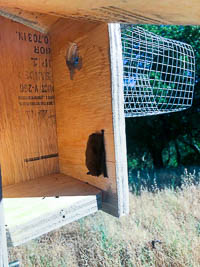
Leave any bats you find alone because they won’t stay long. The bats you find in a nest box are males searching for a colony and they stopped over to take a nap. They rarely enter a nest box that has a live nest in it! All the activity is too noisy for sleepy bats.
Dead Birds
Sadly, during the nesting season, you may find a dead baby bird inside the nest. Using gloves, carefully remove it without disturbing the other baby birds. Bury it far from the nest to prevent predators from detecting it.
House Sparrows and European Starlings
Invasive House Sparrows and European Starlings can populate choice native bird territory and take over valuable habitats.
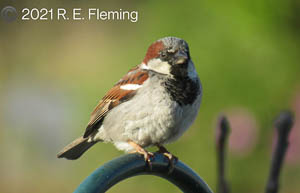
Neither species is protected by the Migratory Treaty Act. The best way to control House Sparrows and Starlings is to avoid installing nest boxes where they live. They will destroy nests, eggs, nestlings, and adults to take over a nest box. If you do find either species trying to nest in one of your boxes, there are methods you can try to deter them.
- Place nest boxes away from human activity and buildings (about 300 feet). Both species strongly prefer to nest near buildings and are almost always close to human habitation.
- If you only have one nest box in your backyard and a House Sparrow tries to take it over, keep removing the nest. They will get tired of rebuilding their nest and give up. If you have more than one box however, and there is an active nest in the other one, the House Sparrows may destroy the bluebirds.
- Switch to providing nest boxes for Chickadees and Titmice. House Sparrows are less likely to try and nest in these smaller boxes.
- Starlings are easier to discourage because they are larger and can’t enter a 1 ½” entry hole. Use a Noel Guard if possible. If not, install the metal entry hole guards to keep the entry hole size 1 ½”.
The North American Bluebird Society (www.nabluebirdsociety.org) and www.sialis.org provides additional information on trapping and other methods of deterring House Sparrows.
Woodpeckers
Now and then, you’ll find the entry hole has been chewed and made larger. This could be the handiwork of a woodpecker and can be prevented by installing a Noel Guard. If you have a front opening box or hanging box, you can install a metal entry hole guard. The other solution is to install a Northern Flicker box in the vicinity. And if a Nuttall’s or Downy Woodpecker has taken over the box, leave them. They need cavities, too.
Install another box nearby for the bluebirds.
Abandoned Baby Birds
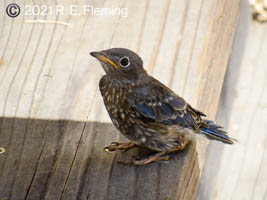
If you clearly see that the chicks in a nest are abandoned, wrap them in a soft towel to keep warm, transport in a paper sack or covered box and take to a wildlife rehab. Baby birds on the ground may well be fledglings that cannot fly yet. Watch to see if the parents are chirping and calling to them. Usually, they will feed the young fledgling and encourage it to fly. If the baby bird is still on the ground at nightfall, try to catch it and keep in a safe place until early morning, then, release into the same area and observe again.
The above guide provides solutions for the most common challenges we face as nest box monitors. You are always welcome to contact us for additional guidance.
